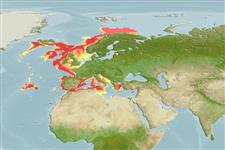Common names from other countries
Classification / Names / Names
Common names | Synonyms | Catalog of Fishes (gen., sp.) | ITIS | CoL | WoRMS
Environment: milieu / climate zone / depth range / distribution range
Ecology
Sessile; depth range 20 - 1279 m (Ref. 85345). Subtropical; 9°C - 12°C (Ref. 127927); 63°N - 34°N, 11°W - 27°E
Atlantic and the Mediterranean Sea: Faeroe Islands west to Ireland, then south to Morocco and east to Aegean Sea.
Length at first maturity / Size / Weight / Age
Maturity: Lm ? range ? - ? cm
Minimum depth from Ref. 127628. Epibenthic (Ref. 87524).
Life cycle and mating behavior
Maturity | Reproduction | Spawning | Eggs | Fecundity | Larvae
Members of the class Crinoidea are gonochoric. During spawning, the pinnule walls rupture and the eggs and sperms are shed into the seawater. Life cycle: Embryos elongate into free-swimming larvae (doliolaria) which later sink to the bottom where they metamorphose into stalked sessile crinoid.
Koukouras, A. and M.-S. Kitsos. 2010. (Ref. 85345)
IUCN Red List Status (Ref. 130435)
CITES status (Ref. 108899)
Not Evaluated
Not Evaluated
Human uses
| FishSource |
Tools
More information
Age/Size
Growth
Length-weight
Length-length
Morphology
Larvae
Abundance
Internet sources
Estimates based on models
Preferred temperature
(Ref.
115969): 7.2 - 13.2, mean 10.2 (based on 83 cells).
Price category
Unknown.
